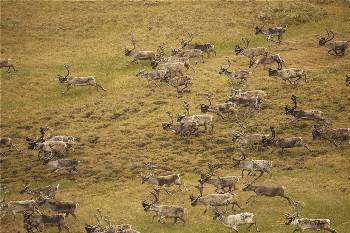Scientists supported by Rosneft started monitoring the wild reindeer number in Taymyr

Biologists of the Siberian Federal University (SFU) conduct large-scale studies of the Taymyr-Evenki population of wild reindeer, involving, among other things, aerial counting of individuals. The project is supported by Rosneft and the Arctic Research Center (the Company’s research institute) as part of the Ecology National Project.
Protection of the environment is an integral part of Rosneft Oil Company’s corporate culture. In the field of conservation, the Company sees its main task in the effective management and minimisation of the impact of its manufacturing activity on the environment and in the conservation of biological diversity in all regions of its presence.
The SFU expedition studies the migratory accumulations of reindeer on the Taymyr Peninsula, in the Byrranga Mountains that separate the tundra from the Arctic Ocean. The researchers’ task is to determine the size of the group, as well as the age-sex composition of the herd. These data will allow us to assess the state of the population, the dynamics of the birth rate this year, as well as the impact of various factors of anthropogenic and natural origin on the reindeer population. In the spring of 2021, 18 deer were tagged with special collars equipped with satellite trackers.
According to various estimates, the current size of the Taymyr-Evenki reindeer population is from 380,000 to 450,000 animals. Scientists consider the changing climate to be one of the main factors affecting the population size. High temperatures, on the one hand, contribute to the “greening” of the tundra, i.e. improve the reindeer’s food supply. On the other hand, they force herds to change migration routes and timing, prematurely leaving the tundra pastures to hide in the taiga zone. Nevertheless, the proportion of calves born this year, according to preliminary data, is 18%-20%, indicating a normal growth of the herd.
According to SFU scientists, there is currently a tendency for reindeer numbers to increase if comprehensive programs for the conservation of this species are implemented. The researchers highlight that not only the balance of Arctic ecosystems depends on the future of this population, but also the support of the economic basis and the traditional way of life of indigenous peoples of the North.
Note for Editors:
Rosneft is implementing the corporate programme of research, conservation and monitoring of key species indicating the sustainability of the Arctic ecosystems, which are polar bear, Atlantic walrus, wild reindeer and ivory gull, the rare gull subspecies listed in the Red Book of the Russian Federation.
Comprehensive field studies are conducted within the programme, providing up-to-date information about the state of the populations living in the Arctic zone of the Russian Federation and their migration routes.
Department of Information and Advertising
Rosneft
30 July,2021